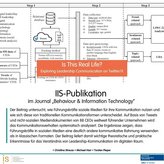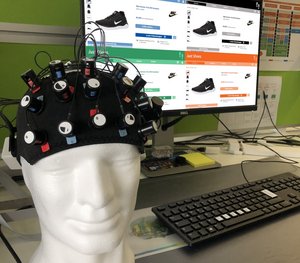Singleview
Thu, 15. Oct 2020 Busch, Jan
Anika Nissen nimmt mit zwei Vorträgen an virtueller ICIS-Konferenz teil
Zwei eingereichte Beiträge von Anika Nissen wurden erfolgreich auf der diesjährigen ICIS-Konferenz akzeptiert. Aufgrund der aktuellen Lage durch Covid-19 findet die Konferenz dieses Jahr virtuell statt. Die ICIS ist die größte, internationale Wirtschaftsinformatik-Konferenz, auf der maximal 28% aller Einreichungen akzeptiert werden. Die zwei erfolgreich platzierten Beiträge seien dabei im folgenden kurz mit ihrem Abstract vorgestellt:
Colors surround us in all life situations and have the power to influence our mood and emotions, which makes color a crucial impact factor for decision making in ecommerce environments. Therefore, this research paper aims to explore the psychological and physiological effects of color use on websites with a neuroimaging method. For this, an experiment was designed in which 24 healthy participants watched an online shoe shop in 4 different colored versions during which their neural activity in the prefrontal cortex was measured. While comparing the neural activity between the different employed colors, distinct implications can be derived. That is, in comparison to the blueish website, (1) grey scaled websites require higher cognitive load but are rated as aesthetically pleasing, (2) greenish websites result in more negative valence while they require not more neural resources, and (3) reddish websites are rated low in valence and require higher neural processing resources.
"Towards Dual Processing of Social Robots: Differences in the Automatic and Reflective System“
Social robots increasingly diffuse into our lives in work, health, and many other areas. However, theoretical approaches that explain how social robots should be designed to maximize experiential and performance-related outcomes in human-robot interaction (HRI) are still rare. To close this research gap, we aim to develop a dual process model of HRI with the help of two experiments. Results of the first experiment show that individuals categorize humans and robots differently in the automatic and reflective system, leading to different forms of robotic biases in these systems. Specifically, whereas humans show a bias against all types of robots in the reflective system, they only show biases against robots with low anthropomorphism in the automatic system. With the second experiment, we aim to complement these results from a neurophysiological perspective to gain more insights into cognitive processes during classification and evaluation of robots.
Latest News:
 IIS-Publikation im "Journal Behaviour & Information Technology"14.10.25
IIS-Publikation im "Journal Behaviour & Information Technology"14.10.25 IIS-Publikationen auf der WI 2025 23.09.25
IIS-Publikationen auf der WI 2025 23.09.25 IIS-Publikation in der Festschrift für Prof. Dr. Zelewski: "Produktions- und Informationsmanagement"05.03.25
IIS-Publikation in der Festschrift für Prof. Dr. Zelewski: "Produktions- und Informationsmanagement"05.03.25 IIS-Talents: Erfahrungsberichte zum Event bei mindsquare09.05.23
IIS-Talents: Erfahrungsberichte zum Event bei mindsquare09.05.23- IIS-Talents: Das sind unsere Events für das Sommersemester 2023!25.04.23
 IIS-Publikationen auf der ECIS 2023 angenommen24.04.23
IIS-Publikationen auf der ECIS 2023 angenommen24.04.23 Zwei SHKs für die Unterstützung eines innovativen Lehrkonzepts gesucht! 18.04.23
Zwei SHKs für die Unterstützung eines innovativen Lehrkonzepts gesucht! 18.04.23 IIS-Publikationen auf der ECIS 2023 angenommen17.04.23
IIS-Publikationen auf der ECIS 2023 angenommen17.04.23 IIS-Talents SS 2023 - jetzt bewerben!11.04.23
IIS-Talents SS 2023 - jetzt bewerben!11.04.23 IIS-Talents: Abschlussevent beim Zeche Zollverein Essen23.03.23
IIS-Talents: Abschlussevent beim Zeche Zollverein Essen23.03.23

